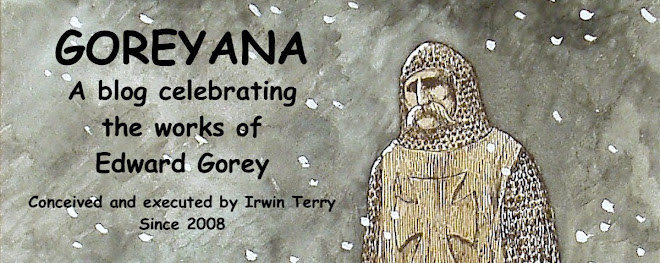 Of the eight lots of original artwork by Edward Gorey auctioned at Swann Auction Galleries in New York City on December 10, 2019, three were created for use in periodicals. The largest piece (image size 12.25" x 9.25") was commissioned as a cover for the January/February 1988 issue of Print Magazine. This fantastic watercolor and pen & ink painting is a fantasy image that leaves the viewer with more questions than it answers. The entire piece can be summed up in one word, "Why?". Why are there floating snakes of various colors? Why are there orange mustaches everywhere? Why is there a gramophone at the seaside? Then again, why not? Mr. Gorey left virtually no room for the title of the magazine to be superimposed on the cover, but the art director managed to squeeze it into the upper right hand corner. This glorious painting sold for $16,250.00 (including buyer's premium).
Of the eight lots of original artwork by Edward Gorey auctioned at Swann Auction Galleries in New York City on December 10, 2019, three were created for use in periodicals. The largest piece (image size 12.25" x 9.25") was commissioned as a cover for the January/February 1988 issue of Print Magazine. This fantastic watercolor and pen & ink painting is a fantasy image that leaves the viewer with more questions than it answers. The entire piece can be summed up in one word, "Why?". Why are there floating snakes of various colors? Why are there orange mustaches everywhere? Why is there a gramophone at the seaside? Then again, why not? Mr. Gorey left virtually no room for the title of the magazine to be superimposed on the cover, but the art director managed to squeeze it into the upper right hand corner. This glorious painting sold for $16,250.00 (including buyer's premium). From the 1970's through the 1990's, Edward Gorey created over 25 spot illustrations for TV Guide Magazine, and all of the pieces have three things in common - they are large, colorful, and imaginative. The weekly magazine could be found next to armchairs in living rooms and lounges across the nation, keeping everyone informed of the upcoming broadcast programming. The pages of program listings were made of cheap newsprint, but a color section had television related articles on all subjects, and Mr. Gorey's commissions reflect the eclectic nature of the articles.
From the 1970's through the 1990's, Edward Gorey created over 25 spot illustrations for TV Guide Magazine, and all of the pieces have three things in common - they are large, colorful, and imaginative. The weekly magazine could be found next to armchairs in living rooms and lounges across the nation, keeping everyone informed of the upcoming broadcast programming. The pages of program listings were made of cheap newsprint, but a color section had television related articles on all subjects, and Mr. Gorey's commissions reflect the eclectic nature of the articles.For this piece on the trend of recording a video will that would be presented to the grieving survivors, Edward Gorey shows the expectant mourners viewing a television propped on the deceased's final conveyance. It is all too obvious by the preferred placement of the cat that the people will come away disappointed in the testamentary distributions of the deceased. This colors for this piece are muted greens and greys, but the art director must have wanted more "pop" on the page and tweaked the colors towards yellow, downplaying the somber tones of the original. All of Mr. Gorey's pieces for TV Guide are drawn large and reduced for the magazine - this piece measures 7.5" x 5.25", which is almost the size of the magazine itself. This fantastic piece sold for $8125.00 (including buyer's premium).
 The third magazine illustration offered was created for the July 19, 1983 issue of Sports Illustrated Magazine for a feature on the history of baseball. This unlikely subject - one cannot imagine an art director saying, "I know, let's commission the art from Edward Gorey! He is a great sports illustrator." - is presented simply, with a strong, compact visual flare. As often happens once the artwork lands in the hands of the art director, the image was severely cropped, tightening the composition but ultimately damaging the finesse of the image. This piece realized $7000.00 (including buyer's premium).
The third magazine illustration offered was created for the July 19, 1983 issue of Sports Illustrated Magazine for a feature on the history of baseball. This unlikely subject - one cannot imagine an art director saying, "I know, let's commission the art from Edward Gorey! He is a great sports illustrator." - is presented simply, with a strong, compact visual flare. As often happens once the artwork lands in the hands of the art director, the image was severely cropped, tightening the composition but ultimately damaging the finesse of the image. This piece realized $7000.00 (including buyer's premium).



















































